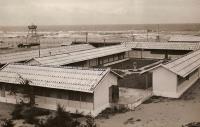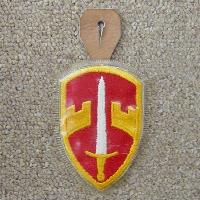
Tim Coughlin
War Story: MACV Advisor
20 February 2006
Tim Coughlin
In 1962 I was stationed in Orleans, France as an SP5 (E-5) and had been in the US Army for approximately 7 years. The big news in the Army at that time was that our old M1 rifles were being replaced with M14's - Vietnam and M16's were unknown to us!
One day I was informed to report to the Personnel Officer to read a message directed to all E5's and above that had Secret clearances or higher, and either a Primary or Secondary MOS (Military Occupational Specialty) in the Combat Arms (my Secondary was Artillery (AAA)).
The message stated that the
MAAG ( Military Assistance Advisory Group ) mission in Vietnam was being expanded and volunteers were being sought. The tour of duty would be 12 months after which you could have your choice of next assignment area worldwide, and you would never be required to serve in Vietnam again. I asked where Vietnam was, and was told it was in South America somewhere! So I signed up, and heard nothing more.
In the summer of 1963 I returned to the States and was assigned to Fort Polk, Louisiana, for what I thought would be the next 3 years. Fort Polk was a basic training camp struggling to stay alive as the Army was closing some of the old WWII bases. I had completely forgotten about Vietnam and it was not a news issue.
On the 2
nd November, the South Vietnamese President,
Ngo Dinh Diem was assassinated along with his advisor brother Ngo Dinh Nhu. Just 20 days later President Kennedy was assassinated in Texas, and the world suddenly began to turn upside down for Americans.
Much to my surprise early in 1964 I received orders to MAAG Vietnam - reporting date about 1
st June 1964. I was to obtain a passport and an allowance was provided to purchase civilian clothing, which was to be worn when directed. Shortly thereafter I received orders changing it to
MACV ( Military Assistance Command Vietnam) , deleting the passport and clothing allowance, and informed to report to Oakland Army Terminal (CA) in mid May 1964.
I reported to Oakland as an SP6 (E6) and waited there about 2 weeks before enough men were gathered for a full plane flight to Vietnam. We flew first to Anchorage, Alaska, then to Japan and the Philippines before finally arriving at Ton Son Nhut Airport in Saigon early on a Saturday morning. The enlisted men were taken to a small hotel in Cholon and told to report Monday morning to MACV Personnel Office for final assignments.
My first 5 months were spent in Saigon and then at my request I was reassigned to "the Field" - MACV Team 28 (20 US Army personnel) in Tuy Hoa, Phu Yen Province near the coast in II Corps Tactical Zone. I arrived in Tuy Hoa on 1
st November 1964 and was stationed there for 4 months. My rank was changed from SP6 to E6 Staff Sergeant (SSG) and my assigned weapon was the Carbine. The only M16 I had ever seen was in the possession of Air Force personnel!

My MACV Pocket Hanger.
My job was Detachment Sergeant and my responsibilities were limited to the MACV Compound operation and going to the South Field (the Tuy Hoa Municipal Airport, which was just a strip and small building) occasionally to pick up supplies and the mail. Other US military personnel were assigned to the various
ARVN ( Army of the Republic of Vietnam ) units for training and coordination purposes.
By early 1965 Vietnam was in the hands of the VC (
Viet Cong) outside of the cities and major towns - travel by road was impossible, and the MACV compounds were in immediate danger of being overrun. There wasn't any patrolling by US military personnel (except maybe for some Special Forces teams) when I was there; it was simply a matter of holding onto the static situations, the cities and major towns.
Shortly after I arrived an ARVN attempt was made to travel the road south and several MACV 28 team members accompanied the regiment. It was stopped dead at South Pass by the VC with many ARVN dead and wounded. All the MACV advisors survived without a scratch, but they had close calls with bullets and shrapnel just missing them. It was an ARVN disaster, and the dead lay there for a few days before villagers were paid to retrieve the bodies. The badly wounded ARVN's were evacuated out of our compound on US Hueys.
The military situation quickly grew worse and on the 9
th December 1964 a major ARVN attack was made on a VC village in our area along the coast. Several US fighter planes were used and 2 or 3 US Huey gun-ships spent the night before in our compound. The crews slept in, or next to, the choppers because we had no beds available.
A US Army Major Stoneburner arrived in our compound a few days before with the purpose, I believe, to assess the overall situation for the Pentagon. The VC hit the motor column heading to the village and Stoneburner was killed by gunfire. His body was rushed back to the compound and I identified it. We then wrapped him in white bed sheets (there were no body bags then) and put him on a Huey. He had been In-Country just one week!
Around 1
st March 1965 I was reassigned for my last 3 months to MACV 82 in Ham Tan, Binh Thuan province, which was located in the southern coastal corner of II Corps Tactical Zone. It was a small compound near the District Headquarters with about 10 US Army personnel.
There really wasn't any town there, and the situation was very bad with the VC pressing on the location, almost to the point of overrunning it. ARVN troops were dug in on the hilltop next to us, and an ARVN 105 battery was across the road from us. The 105's did a lot of firing, and every night around midnight they would let loose with a volley. No reinforcements were available, and if we were overrun our only hope was to make it through the jungle to the coast, about 5 miles away. If we made it the Navy might have been able to rescue us, as they had several ships in the area.
The Pentagon announced it was sending Army Military Police units and the Marines to Vietnam – and the rest is history. I left Vietnam in the 1st half of June 1965, happy to get out of there in one piece. End of story!
Tim Coughlin.
Follow us on


Copyright © VietnamGear.com. All
rights reserved. This material is intended solely for internal use within VietnamGear.com.
Any other reproduction, publication or redistribution of this material without the
written agreement of the copyright owner is strictly forbidden and any breach of
copyright will be considered actionable